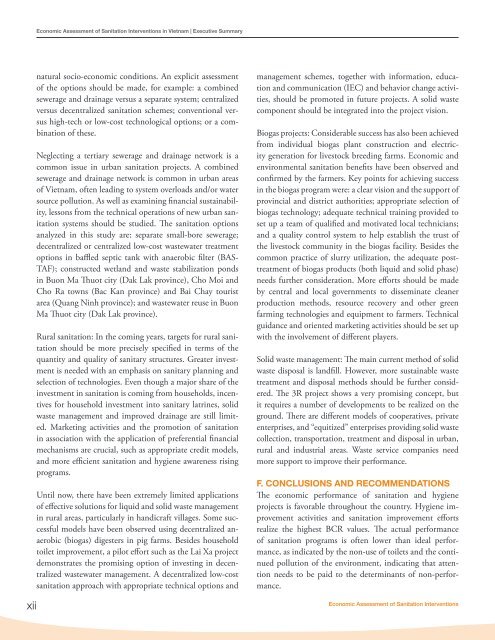Economic Assessment of Sanitation Interventions in Vietnam - WSP
Economic Assessment of Sanitation Interventions in Vietnam - WSP
Economic Assessment of Sanitation Interventions in Vietnam - WSP
Create successful ePaper yourself
Turn your PDF publications into a flip-book with our unique Google optimized e-Paper software.
<strong>Economic</strong> <strong>Assessment</strong> <strong>of</strong> <strong>Sanitation</strong> <strong>Interventions</strong> <strong>in</strong> <strong>Vietnam</strong> | Executive Summaryxi<strong>in</strong>atural socio-economic conditions. An explicit assessment<strong>of</strong> the options should be made, for example: a comb<strong>in</strong>edsewerage and dra<strong>in</strong>age versus a separate system; centralizedversus decentralized sanitation schemes; conventional versushigh-tech or low-cost technological options; or a comb<strong>in</strong>ation<strong>of</strong> these.Neglect<strong>in</strong>g a tertiary sewerage and dra<strong>in</strong>age network is acommon issue <strong>in</strong> urban sanitation projects. A comb<strong>in</strong>edsewerage and dra<strong>in</strong>age network is common <strong>in</strong> urban areas<strong>of</strong> <strong>Vietnam</strong>, <strong>of</strong>ten lead<strong>in</strong>g to system overloads and/or watersource pollution. As well as exam<strong>in</strong><strong>in</strong>g f<strong>in</strong>ancial susta<strong>in</strong>ability,lessons from the technical operations <strong>of</strong> new urban sanitationsystems should be studied. The sanitation optionsanalyzed <strong>in</strong> this study are: separate small-bore sewerage;decentralized or centralized low-cost wastewater treatmentoptions <strong>in</strong> baffled septic tank with anaerobic filter (BAS-TAF); constructed wetland and waste stabilization ponds<strong>in</strong> Buon Ma Thuot city (Dak Lak prov<strong>in</strong>ce), Cho Moi andCho Ra towns (Bac Kan prov<strong>in</strong>ce) and Bai Chay touristarea (Quang N<strong>in</strong>h prov<strong>in</strong>ce); and wastewater reuse <strong>in</strong> BuonMa Thuot city (Dak Lak prov<strong>in</strong>ce).Rural sanitation: In the com<strong>in</strong>g years, targets for rural sanitationshould be more precisely specified <strong>in</strong> terms <strong>of</strong> thequantity and quality <strong>of</strong> sanitary structures. Greater <strong>in</strong>vestmentis needed with an emphasis on sanitary plann<strong>in</strong>g andselection <strong>of</strong> technologies. Even though a major share <strong>of</strong> the<strong>in</strong>vestment <strong>in</strong> sanitation is com<strong>in</strong>g from households, <strong>in</strong>centivesfor household <strong>in</strong>vestment <strong>in</strong>to sanitary latr<strong>in</strong>es, solidwaste management and improved dra<strong>in</strong>age are still limited.Market<strong>in</strong>g activities and the promotion <strong>of</strong> sanitation<strong>in</strong> association with the application <strong>of</strong> preferential f<strong>in</strong>ancialmechanisms are crucial, such as appropriate credit models,and more efficient sanitation and hygiene awareness ris<strong>in</strong>gprograms.Until now, there have been extremely limited applications<strong>of</strong> effective solutions for liquid and solid waste management<strong>in</strong> rural areas, particularly <strong>in</strong> handicraft villages. Some successfulmodels have been observed us<strong>in</strong>g decentralized anaerobic(biogas) digesters <strong>in</strong> pig farms. Besides householdtoilet improvement, a pilot effort such as the Lai Xa projectdemonstrates the promis<strong>in</strong>g option <strong>of</strong> <strong>in</strong>vest<strong>in</strong>g <strong>in</strong> decentralizedwastewater management. A decentralized low-costsanitation approach with appropriate technical options andmanagement schemes, together with <strong>in</strong>formation, educationand communication (IEC) and behavior change activities,should be promoted <strong>in</strong> future projects. A solid wastecomponent should be <strong>in</strong>tegrated <strong>in</strong>to the project vision.Biogas projects: Considerable success has also been achievedfrom <strong>in</strong>dividual biogas plant construction and electricitygeneration for livestock breed<strong>in</strong>g farms. <strong>Economic</strong> andenvironmental sanitation benefits have been observed andconfirmed by the farmers. Key po<strong>in</strong>ts for achiev<strong>in</strong>g success<strong>in</strong> the biogas program were: a clear vision and the support <strong>of</strong>prov<strong>in</strong>cial and district authorities; appropriate selection <strong>of</strong>biogas technology; adequate technical tra<strong>in</strong><strong>in</strong>g provided toset up a team <strong>of</strong> qualified and motivated local technicians;and a quality control system to help establish the trust <strong>of</strong>the livestock community <strong>in</strong> the biogas facility. Besides thecommon practice <strong>of</strong> slurry utilization, the adequate posttreatment<strong>of</strong> biogas products (both liquid and solid phase)needs further consideration. More efforts should be madeby central and local governments to dissem<strong>in</strong>ate cleanerproduction methods, resource recovery and other greenfarm<strong>in</strong>g technologies and equipment to farmers. Technicalguidance and oriented market<strong>in</strong>g activities should be set upwith the <strong>in</strong>volvement <strong>of</strong> different players.Solid waste management: The ma<strong>in</strong> current method <strong>of</strong> solidwaste disposal is landfill. However, more susta<strong>in</strong>able wastetreatment and disposal methods should be further considered.The 3R project shows a very promis<strong>in</strong>g concept, butit requires a number <strong>of</strong> developments to be realized on theground. There are different models <strong>of</strong> cooperatives, privateenterprises, and “equitized” enterprises provid<strong>in</strong>g solid wastecollection, transportation, treatment and disposal <strong>in</strong> urban,rural and <strong>in</strong>dustrial areas. Waste service companies needmore support to improve their performance.F. CONCLUSIONS AND RECOMMENDATIONSThe economic performance <strong>of</strong> sanitation and hygieneprojects is favorable throughout the country. Hygiene improvementactivities and sanitation improvement effortsrealize the highest BCR values. The actual performance<strong>of</strong> sanitation programs is <strong>of</strong>ten lower than ideal performance,as <strong>in</strong>dicated by the non-use <strong>of</strong> toilets and the cont<strong>in</strong>uedpollution <strong>of</strong> the environment, <strong>in</strong>dicat<strong>in</strong>g that attentionneeds to be paid to the determ<strong>in</strong>ants <strong>of</strong> non-performance.<strong>Economic</strong> <strong>Assessment</strong> <strong>of</strong> <strong>Sanitation</strong> <strong>Interventions</strong>
















